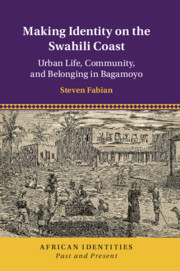Book contents
- Making Identity on the Swahili Coast
- African Identities: Past and Present
- Making Identity on the Swahili Coast
- Copyright page
- Dedication
- Contents
- Illustrations
- Preface
- A Note on Spellings and Currency
- A Note on Nomenclature
- Abbreviations
- Maps
- Introduction
- Part One Becoming Bagamoyo
- Part Two Fitting into their Way of Life: Local Community and Colonial Control
- 4 The Particularities of Place
- 5 Colonial Power, Community Identity, and Consultation
- 6 “Curing the Cancer of the Colony”
- Epilogue
- Glossary
- Select Bibliography
- Index
5 - Colonial Power, Community Identity, and Consultation
from Part Two - Fitting into their Way of Life: Local Community and Colonial Control
Published online by Cambridge University Press: 28 October 2019
- Making Identity on the Swahili Coast
- African Identities: Past and Present
- Making Identity on the Swahili Coast
- Copyright page
- Dedication
- Contents
- Illustrations
- Preface
- A Note on Spellings and Currency
- A Note on Nomenclature
- Abbreviations
- Maps
- Introduction
- Part One Becoming Bagamoyo
- Part Two Fitting into their Way of Life: Local Community and Colonial Control
- 4 The Particularities of Place
- 5 Colonial Power, Community Identity, and Consultation
- 6 “Curing the Cancer of the Colony”
- Epilogue
- Glossary
- Select Bibliography
- Index
Summary
Instead of distancing colonial authority figures from the African communities they governed, of seeing these groups as mutually exclusive, this chapter seeks to situate these officials in the communities they served and understand how their behavior was consequently affected. European teachers and colonial officers, as well as their intermediaries, consulted with the various communities which made up Bagamoyo and, in particular, paid respect to elders and parents. This focus on colonial-African relations complicates our image of imperial rule: far from a style of administration characterized by social distancing, some colonial officials ultimately became immersed in the social codes of the communities they were supposed to dominate. This chapter provides a comparative examination of this phenomenon through two rounds of European colonialism in Tanganyika: the German and British empires. It examines issues such as urban planning, taxation, slavery, racial identification, colonial administration, and school enrollment.
- Type
- Chapter
- Information
- Making Identity on the Swahili CoastUrban Life, Community, and Belonging in Bagamoyo, pp. 211 - 260Publisher: Cambridge University PressPrint publication year: 2019

